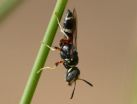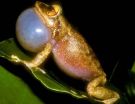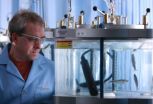(Press-News.org) DURHAM, N.C. -- During the age of the dinosaurs, the arrival of flowering plants as competitors could have spelled doom for the ancient fern lineage. Instead, ferns diversified and flourished under the new canopy -- using a mysterious gene that helped them adapt to low-light environments.
A team led by Duke University scientists has pinpointed the curious origins of this gene and determined that it was transferred to ferns from a group of unassuming moss-like plants called hornworts. The findings were announced today, April 14, in the Proceedings of the National Academy of Sciences.
For years, researchers have suspected that a gene called neochrome played a role in the evolution of ferns. Neochrome is a hybrid of two other plant genes which code for photoreceptor proteins that sense blue and red light.
"Neochrome is a 'chimeric' gene," said Fay-Wei Li, lead author and Ph.D. student in Duke's biology department. It produces a photoreceptor that senses both blue and red light, affording ferns a unique advantage in forests shaded by flowering plants. "Most plants sense and grow toward blue light, but under the canopy, the filtered light spectrum has more red light than blue."
"Neochrome helped ferns to 'see' better," Li said. What hasn't been crystal clear is the gene's origin. Li set out to investigate its evolution by systematically combing through plant genomes from the Duke Herbarium and 1000 Plants Initiative.
Neochrome turned up in a surprising place: the genomes of hornworts, a damp-loving plant group related to mosses.
Three scenarios could have explained how the gene came to be shared by ferns and hornworts: 1) a common ancestor that had the gene; 2) independent evolution of the gene in both groups; or 3) a process called horizontal gene transfer, which ferried neochrome from one group to the other.
To sort out these theories, the team looked not only at the evolutionary relationships of land plants and algae, but also at how all of their light-sensitive genes were related.
Ferns and hornworts diverged in evolution 400 million years ago. If neochrome came from a common ancestor, it would have been passed on to many other plant families, too. But then it had to have been lost in all but the ferns, since no seed plants still have it. The analysis also didn't support the idea that an unusual gene like neochrome evolved independently in both hornworts and ferns.
What the scientists found instead was strong evidence that the fern version of neochrome descended from the hornwort version. By looking at sequence changes in the gene's various spellings, they constructed a family tree of light-sensitive genes, in which fern neochrome "nested" neatly within the hornwort lineage. The analysis also showed that the gene versions separated about 179 million years ago.
Only one mechanism could explain how the gene hopped from hornworts to ferns so long after the lineages themselves diverged: horizontal gene transfer. But researchers have only just begun to explore how this occurs in plants.
"We're actually seeing more and more incidence of horizontal gene transfer in plants, but there's no definite answer as to what mediates it," Li said.
In the microbial world, bacteria, fungi and viruses have been shown to mediate horizontal gene transfer wherever bits of genetic material get mixed up in different organisms. It's a messy affair, but it can have powerful evolutionary consequences -- gene transfer is how many bacteria learn antibiotic resistance, for example.
"You have to have cell contact," Li said. Ferns have a unique life cycle that might lend itself to horizontal gene transfer, he added. Gametophytes, the fern form that produces sex cells, are promiscuous little plants.
"They have no protective layer on top, no cuticle," said Kathleen Pryer, an authority on ferns and professor of biology at Duke. "A gametophyte is also a really compact structure, and the sex organs are right there, with lots of contact with other plants that are all competing for light and space."
Easy access to a fern's sperm and eggs could mean foreign genetic material -- like the gene neochrome -- might easily be passed on to the subsequent generation. However neochrome was transferred, it seems to have occurred at just the right moment in ferns' evolutionary history.
"The acquisition of hornwort neochrome appears responsible for the expansion of the fern lineage in the shade of angiosperms (flowering plants)," said J. Clark Lagarias, professor of biochemistry at the University of California, Davis, who was not involved with this research.
Fay-Wei Li will continue to unravel the history of neochrome for his dissertation.
INFORMATION:
This work was supported by research grants from the Society of Systematic Biologists, Sigma Xi, American Society of Plant Taxonomists, Duke University, the National Science Foundation (Grant DEB-1145614 and a Graduate Research Fellowship), and a European Research Council Advanced Investigator Award.
CITATION: "Horizontal transfer of an adaptive chimeric photoreceptor from bryophytes to ferns," Fay-Wei Li, Juan Carlos Villarreal, Steven Kelly, et al. Proceedings of the National Academy of Sciences, April 14, 2014. DOI: http://dx.doi.org/10.5061/dryad.fn2rg
Ferns borrowed genes to flourish in low light
Bumping sex cells with the hornworts may have done it
2014-04-14
ELSE PRESS RELEASES FROM THIS DATE:
Plugging an ozone hole
2014-04-14
CAMBRIDGE, Mass-- Since the discovery of the Antarctic ozone hole, scientists, policymakers, and the public have wondered whether we might someday see a similarly extreme depletion of ozone over the Arctic.
But a new MIT study finds some cause for optimism: Ozone levels in the Arctic haven't yet sunk to the extreme lows seen in Antarctica, in part because international efforts to limit ozone-depleting chemicals have been successful.
"While there is certainly some depletion of Arctic ozone, the extremes of Antarctica so far are very different from what we find in the ...
Fire and drought may push Amazonian forests beyond tipping point
2014-04-14
Falmouth, Mass. – Future simulations of climate in the Amazon suggest a longer dry season leading to more drought and fires. Woods Hole Research Center scientists Michael Coe, Paulo Brando, Marcia Macedo and colleagues have published a new study on the impacts of fire and drought on Amazon tree mortality. Their paper entitled “Abrupt increases in Amazonian tree mortality due to drought-fire interactions,” published in the Proceedings of the National Academy of Sciences, found that prolonged droughts caused more intense and widespread wildfires, which consumed more forests ...
Faithful allies since the Cretaceous
2014-04-14
Like humans, many animals depend on beneficial microbes for survival. Although such symbioses can persist for millions of years, the factors maintaining their long-term stability remain, in most cases, unknown. Scientists from the Max Planck Institute for Chemical Ecology and the University of Regensburg, in collaboration with researchers in the USA, now discovered that certain wasps tightly control mother-to-offspring transmission of their bacterial symbionts. This stabilizes the symbiotic alliance and contributed to its persistence over the past 68-110 million years. ...
'Problem wells' source of greenhouse gas at unexpected stage of natural gas production
2014-04-14
WEST LAFAYETTE, Ind. - High levels of the greenhouse gas methane were found above shale gas wells at a production point not thought to be an important emissions source, according to a study jointly led by Purdue and Cornell universities. The findings could have implications for the evaluation of the environmental impacts from natural gas production.
The study, which is one of only a few to use a so-called "top down" approach that measures methane gas levels in the air above wells, identified seven individual well pads with high emission levels and established their stage ...
Penicillin redux: Rearming proven warriors for the 21st century
2014-04-14
Penicillin, one of the scientific marvels of the 20th century, is currently losing a lot of battles it once won against bacterial infections. But scientists at the University of South Carolina have just reported a new approach to restoring its combat effectiveness, even against so-called "superbugs."
Bacteria have been chipping away at the power of the penicillin family of drugs since their first wide-scale use as antibiotics in the 1940s. For example, the staph infection, brought about by the bacterium Staphylococcus aureus, was once readily treated with penicillin and ...
Study links severe sleep apnea to increased risk of stroke, cancer and death
2014-04-14
DARIEN, IL – A new study shows that moderate to severe obstructive sleep apnea is independently associated with an increased risk of stroke, cancer and death.
Results of the 20-year follow-up study show that people with moderate to severe obstructive sleep apnea were four times more likely to die (hazard ratio = 4.2), nearly four times more likely to have a stroke (HR = 3.7), three times more likely to die from cancer (HR = 3.4), and 2.5 times more likely to develop cancer. Results were adjusted for potential confounding factors such as body mass index, smoking status, ...
Shared decision making during radiation therapy improves patient satisfaction
2014-04-14
PHILADELPHIA—Playing an active role in their radiation treatment decisions leaves cancer patients feeling more satisfied with their care, and may even relieve psychological distress around the experience, researchers from the Perelman School of Medicine at the University of Pennsylvania report in the journal Cancer.
In a study of 305 patients undergoing radiation treatment, Neha Vapiwala, MD, an associate professor in the department in Radiation Oncology at Penn Medicine, and colleagues at link "Penn's...Center: Penn's Abramson Cancer Center found an association between ...
Plague alters cell death to kill host
2014-04-14
Northwestern Medicine scientists are continuing to unravel the molecular changes that underlie one of the world's deadliest and most infamous respiratory infections.
When the bacterium Yersinia pestis enters the lungs, it causes pneumonic plague, a disease that is 100 percent fatal if untreated. The way in which Y. pestis evades the immune system and kills people in a matter of days has largely confounded scientists, until now.
Following a 2007 study demonstrating that the presence of a protein called the plasminogen activator protease (Pla) is required for Y. pestis ...
Climate change a likely culprit in coqui frog's altered calls, say UCLA biologists
2014-04-14
Changes in the Puerto Rican climate over the past three decades have caused small but significant changes to the coqui frog, the territory's national animal. UCLA biologists have found that not only have male coquis become smaller, but their mating call has also become shorter and higher pitched.
Authored by Peter Narins, UCLA distinguished professor of integrative biology and physiology and of ecology and evolutionary biology, and Sebastiaan Meenderink, a UCLA physics researcher, the study examined 170 male coqui frogs (Eleutherodactylus coqui) in 1983 and then 116 ...
Making dams safer for fish around the world
2014-04-14
RICHLAND, Wash. – Think of the pressure change you feel when an elevator zips you up multiple floors in a tall building. Imagine how you'd feel if that elevator carried you all the way up to the top of Mt. Everest – in the blink of an eye.
That's similar to what many fish experience when they travel through the turbulent waters near a dam. For some, the change in pressure is simply too big, too fast, and they die or are seriously injured.
In an article in the March issue of the journal Fisheries, ecologists from the Department of Energy's Pacific Northwest National ...
LAST 30 PRESS RELEASES:
Decoupling the HOR enhancement on PtRu: Dynamically matching interfacial water to reaction coordinates
Sulfur isn’t poisonous when it synergistically acts with phosphine in olefins hydroformylation
URI researchers uncover molecular mechanisms behind speciation in corals
Chitin based carbon aerogel offers a cleaner way to store thermal energy
Tracing hidden sources of nitrate pollution in rapidly changing rural urban landscapes
Viruses on plastic pollution may quietly accelerate the spread of antibiotic resistance
Three UH Rainbow Babies & Children’s faculty elected to prestigious American Pediatric Society
Tunnel resilience models unveiled to aid post-earthquake recovery
Satellite communication systems: the future of 5G/6G connectivity
Space computing power networks: a new frontier for satellite technologies
Experiments advance potential of protein that makes hydrogen sulfide as a therapeutic target for Alzheimer’s disease
Examining private equity’s role in fertility care
Current Molecular Pharmacology achieves a landmark: real-time CiteScore advances to 7.2
Skeletal muscle epigenetic clocks developed using postmortem tissue from an Asian population
Estimating unemployment rates with social media data
Climate policies can backfire by eroding “green” values, study finds
Too much screen time too soon? A*STAR study links infant screen exposure to brain changes and teen anxiety
Global psychiatry mourns Professor Dan Stein, visionary who transformed mental health science across Africa and beyond
KIST develops eco-friendly palladium recovery technology to safeguard resource security
Statins significantly reduce mortality risk for adults with diabetes, regardless of cardiovascular risk
Brain immune cells may drive more damage in females than males with Alzheimer’s
Evidence-based recommendations empower clinicians to manage epilepsy in pregnancy
Fungus turns bark beetles’ defenses against them
There are new antivirals being tested for herpesviruses. Scientists now know how they work
CDI scientist, colleagues author review of global burden of fungus Candida auris
How does stroke influence speech comprehension?
B cells transiently unlock their plasticity, risking lymphoma development
Advanced AI dodel predicts spoken language outcomes in deaf children after cochlear implants
Multimodal imaging-based cerebral blood flow prediction model development in simulated microgravity
Accelerated streaming subgraph matching framework is faster, more robust, and scalable
[Press-News.org] Ferns borrowed genes to flourish in low lightBumping sex cells with the hornworts may have done it






